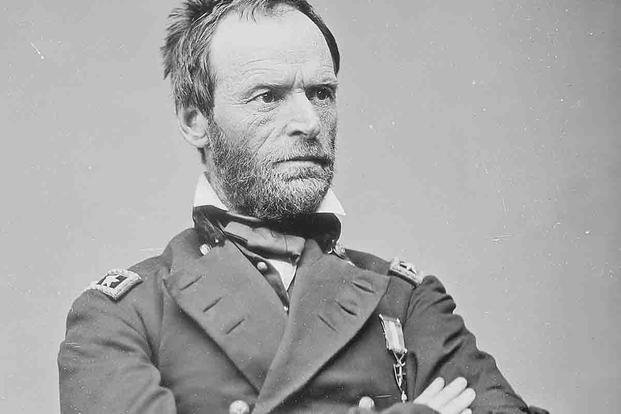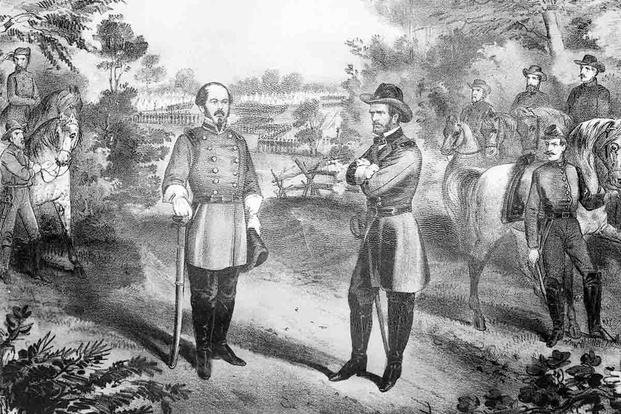When Confederate Gen. Robert E. Lee surrendered the army of Northern Virginia to Gen. Ulysses S. Grant on April 9, 1865, he surrendered an estimated 28,000 Confederate troops. Many remember this moment as the end of the American Civil War, but it wasn't the last army to give up to federal troops.
Appomattox might have been the most famous surrender in the war, but it wasn't the largest. Confederate troops could have continued the fight, and Confederate President Jefferson Davis wanted them to do so. There were still several rebel armies in the field, but they weren't out to fight. They were going to negotiate their safe passage home and the end of the Civil War.
The largest surrender came when Confederate Gen. Joseph E. Johnston surrendered to Gen. William T. Sherman at Bennett Place, North Carolina. It wasn't until Johnston and Sherman agreed to terms that the war effectively ended, weeks after the surrender at Appomattox.
Sherman famously (or infamously, depending on which side of the Mason-Dixon Line you're on) marched to the sea between Nov. 15 and Dec. 21, 1864. His army left a path of destruction from Atlanta to Savannah, Georgia. After his March to the Sea, he turned his army north toward the Carolinas.

As Sherman entered Raleigh in April 1865, Lee's army of Northern Virginia had already given up. The only force to stand in the way of Sherman and his brand of total war with the South was Johnston and his force of more than 89,000 Confederate troops. Instead of continuing the fight, however, Johnston sought a meeting with Sherman.
The two sides met at a farm owned by James and Nancy Bennett to negotiate terms of surrender on April 17, 1865. The Confederate forces not only wanted paroles and pardons for the soldiers in Johnston's army, but they also wanted the reestablishment of state governments in place before the war. Sherman agreed initially, but he received a telegraph informing him of the assassination of President Abraham Lincoln two days earlier.
Lincoln wanted a more sympathetic and compassionate resolution to the war. He wanted to pardon all Confederate troops, protect the private property of Southern landowners and allow the states autonomy in rebuilding and rejoining the Union. With Lincoln dead, the North was out for justice.
U.S. Secretary of War Edwin Stanton and Lincoln's cabinet rejected the agreed terms of surrender and ordered Sherman to renegotiate on military terms only. Johnston met with Davis in Goldsboro, North Carolina, where Davis ordered Johnston to escape from North Carolina with his cavalry and reject the negotiations.
Johnston disobeyed Davis' orders, telling the Confederate president that the people of the South were tired of war, considered themselves defeated and that his army was deserting en masse.
Johnston met with Sherman once more on April 26, 1865. The two sides came to agree to essentially the same terms Grant and Lee agreed to at Appomattox Court House. More than 89,000 Confederate soldiers were allowed to return to their homes and were given 10 days' rations. With the end of the Civil War in the southeastern United States, Sherman began distributing food to southern civilians.
Substantial Confederate armies were still in the field, but none was as large or essential to continuing the rebellion as Johnston's. Davis considered the surrender an act of treachery, even as Johnston was held by Union forces until May 2. Johnston never forgot Sherman's generosity in the surrender agreement, and the two became close friends for the rest of their lives.
-- Blake Stilwell can be reached at blake.stilwell@military.com. He can also be found on Twitter @blakestilwell or on Facebook.
Want to Learn More About Military Life?
Whether you're thinking of joining the military, looking for post-military careers or keeping up with military life and benefits, Military.com has you covered. Subscribe to Military.com to have military news, updates and resources delivered directly to your inbox.
















